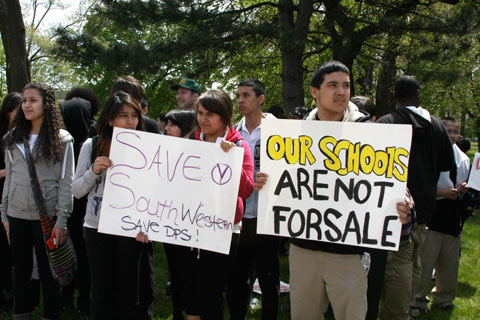At the end of September, an article about potential Detroit school closings was released and I’ve been thinking about it all month. I am by no means an expert on education, but serving with City Year Detroit last year and continuing involvement in public education this year at Wayne County Community College District has me posing more questions than ever before.
The article listed 27 schools that were in the bottom 5% of school rankings in 2014 and 2015 – if they land in that bracket this year too, they will have to shut down by law. Except in cases where closure would cause “unreasonable hardship” to students.
What defines “unreasonable hardship”? If all of the schools on the list were to close, 16,148 students would be displaced based on enrollment as of March 2016 (10,456 from elementary/elementary-middle schools and 5,692 high school students). Four of the high schools on the list – Cody, King, Osborn, and Western International High School- are community schools, meaning they offer services to parents and children but also serve a high portion of students that live nearest to the school. Detroit Public Schools offers no formal school bussing system for high school students, with the exception of students with certain special education requirements. Does traveling farther on foot or via unreliable public transportation, and the safety concerns with both, count as “unreasonable hardship?”
 Detroit students protesting against the closure of Southwestern High School in 2012. Another high school in southwest Detroit, Western International High School has been in the bottom 5% the past 2 years.
Detroit students protesting against the closure of Southwestern High School in 2012. Another high school in southwest Detroit, Western International High School has been in the bottom 5% the past 2 years.
I received high-quality education throughout my whole life, entirely due to my parents’ income. I am incredibly grateful for the opportunities I received, and I realize that if it weren’t for them, my educational experience would have been very different. 85% of children from families in the highest income quartile complete a college degree while less than 8% of children from families in the lowest income quartile (The Future of the Urban Community College: Shaping the Pathways to Multiracial Democracy, 2013). When education is so very connected to income, how is the cycle of poverty broken? Those who receive more education make more, and then their children are more and more likely to receive more education.
We need to do better. Does our society really believe that, “Education is the most powerful weapon you can use to change the world?” It doesn’t seem like it. In order to offer opportunities and resources to more children whose families fall outside of the highest income quartile, we have to show that we place value in education and INVEST. The current education system is failing the children within it. Failing, while severe, is not an exaggeration -the majority of students who enroll in community colleges directly out of high school are placed in remedial classes because they are not prepared for college. We need to build a stronger system and do right for the current students and all of those to come.
